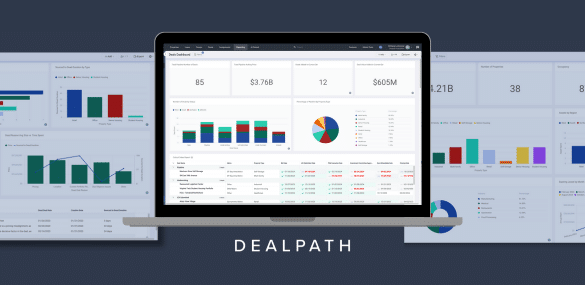This blog post was last edited on Wednesday, April 5th, 2023.
As an asset class, commercial real estate encompasses any property that’s specifically intended for business activities, with the goal of appreciation and generating rental income. The real estate asset class includes numerous property types, offering investors with unique strategies various options when it comes to target risk and return. Specializing in one (or several) property types enables investors to develop operational advantages, competitive intelligence and market expertise.
Not all properties of a certain classification offer the same opportunities, though. By building a pipeline of deals from the same asset class, deal teams can more readily compare apples to apples when it comes to cap rates, IRR and other metrics, particularly when utilizing a deal management platform. Read on to learn more about the real estate asset class, and the various property types that your firm can pursue to deliver risk-adjusted returns.
Types of Commercial Real Estate
- Multifamily
- Office
- Industrial
- Retail
- Hotels & Hospitality
- Land
- Mixed Use
- Special Purpose
- Self Storage
- Life Sciences
What’s a Real Estate Asset Class?
From stocks to bonds, private equity and structured products, real estate is an asset class that investors invest in to generate returns. Sometimes referred to as real estate asset classes, property types distinguish between intended uses among commercial properties. Various asset classes often carry underlying advantages and disadvantages when it comes to market dynamics, price, location, density and more.
While there are significant differences, one asset class isn’t necessarily better than another. Analyzing the types of commercial real estate helps investors to make informed investment decisions based on target risk and return.
10 Types of Commercial Real Estate Buildings & Properties
1. Multifamily
The term multifamily real estate comprises all residential real estate, with the exception of single-family homes. This type of commercial real estate includes high-priority investments like apartments, co-ops, townhomes, and more. Multifamily properties are often further subdivided into Class A, Class B, and Class C properties depending on their location, condition, and more.
Living spaces are essential, meaning multifamily buildings will always carry some degree of value, regardless of market conditions. Nonetheless, market factors influence the viability of opportunities across geographies. Investors also raise rent annually to balance net operating income with inflation.
Some of the most common types of buildings within the multifamily real estate asset class include:
- Duplex, Triplex and Quadplex: Rental properties that are divided into two-unit, three-unit, and four-unit homes, respectively. These types of buildings are available in nearly every market.
- Garden Apartments: Low-rise rental apartment buildings that typically offer tenants shared outdoor space, yards, or gardens. Garden apartments are typically located in the suburbs, but can be anywhere.
- Mid-Rise Apartments: Multifamily rental apartment buildings with at least 5 or more stories and an elevator, which are generally located in urban areas.
- High-Rise Apartments: Multifamily rental apartment buildings with at least 10 or more stories and an elevator, which are generally located in larger, more densely populated markets. Most high-rise apartments have over 100 units, with professional management overseeing leases and maintenance.
- Walk-Up: An apartment building with 4-6 stories, and by definition, no elevator.
- Student Housing: Properties built specifically for student use in areas close to colleges and corresponding downtown areas. Many have large common areas.
- Senior & Assisted Living: Properties built specifically for seniors, which are normally in neighborhoods where elderly populations reside.
Read the case study to learn how L+M Development Partners created an “always-on” process to boost efficiency and predictability with Dealpath.
2. Office
Office buildings account for another major real estate asset class. Ranging from single-story suburban buildings to multi-story urban buildings, office buildings can be lucrative. However, waning in-office attendance has created headwinds for office investors, even as companies prioritize quality space and employee experience.
Because most office buildings are developed for multiple tenants, investors can generate several revenue streams. This structure provides a level of income diversity, helping investors to retain cash flow even in the event that a tenant terminates a lease. Compared to other types of commercial real estate properties, office leases tend to be longer, too. As a result, office investors don’t take on as much risk. Preparing spaces for new tenants, though, can be capital-intensive.
Office buildings are generally divided into three classes, based on the building’s age, condition, location, and more:
- Class A Office Buildings: The highest quality office buildings available, with higher-than-average rents compared to neighboring buildings. Most are newly renovated, easily accessible in city areas, and offer tenants desirable amenities. Class A buildings are usually located in the central business district of the city.
- Class B Office Buildings: Competitive buildings that are generally priced around standard market rates. While they tend not to be in highly sought-after locations, Class B buildings may be similar in quality to Class A buildings.
- Class C Office Buildings: Less-than-ideal quality buildings that tend to be priced below average market rates. Class C office buildings may provide tenants with usable space, but without added perks like amenities and accessible locations.
3. Industrial
Industrial buildings are an attractive investment due to their long-term return and leases, as well as low overhead costs.
Unlike other types of commercial real estate, industrial buildings are often located along interstate highways for added convenience in shipping and delivery. Especially as the eCommerce boom continues, and order fulfillment requires reimagined delivery infrastructure, industrial warehouses are in high demand.
There are a few different types of industrial buildings, which vary in size, layout, format, and in other ways:
- Heavy Manufacturing: Buildings that have undergone significant transformation to cater to the manufacturer’s unique machinery and process, which can’t easily be occupied by another tenant.
- Light Assembly: Buildings that are used for production and/or storage, but without tenant-specific floor plans.
- Bulk Warehouse: Large warehouses that are used for product distribution. Often, manufacturers will divide bulk warehouses by region, with strategic locations based on supply chains.
- Flex Industrial: Buildings that contain industrial storage and/or production space, as well as office space for corporate personnel.
Read the case study to learn how Dermody Properties grew AUM by 400% through operational efficiencies on Dealpath.
4. Retail
In commercial real estate, the label retail applies to any buildings occupied by businesses offering products and services to customers, including stores, restaurants and more. The eCommerce boom has caused retail foot traffic to decline, but this type of commercial real estate still plays an important role in new ways within the retail business model.
Compared to other real estate asset classes, retail buildings tend to have longer leases. For investors, this means a stable source of cash flow, without questions about future income.
Retail properties are organized into several different categories, which vary significantly depending on the location, size, and other factors:
- Strip Malls and Shopping Centers: Clusters of stores that are grouped together, often in one or several unified buildings, to provide a centralized shopping experience. Some may have anchor tenants, or more noteworthy businesses that drive customers in and lead them to other stores.
- Community Retail Center: Complexes that generally have more than one anchor tenant and several smaller businesses, normally spanning 150,000-300,000 square feet.
- Power Center: A shopping center typically located near an interstate highway with at least one anchor tenant. Power centers typically have outparcels.
- Regional Mall: A larger complex offering a variety of retail and restaurant options with several anchor tenants, such as big box retailers. Malls normally span 400,000 to 2,000,000 square feet, including higher-end shops, restaurants, and entertainment options.
- Outparcel: Parcels of land within other larger plots leased to other tenants, such as shops, restaurants, fast food, chains, and more. Outparcels tend to rely on larger buildings for foot traffic.
5. Hotels & Hospitality
The hotels and hospitality category comprises buildings offering both short-and long-term accommodations to travelers, both for leisure or business purposes.
Some hotels are owned by a corporation, operating as part of a chain. Boutique hotels typically feature a unique and thematic design concept, and are typically privately owned. These are some of the most common types of hotels:
- Limited Service: Facilities where residents are left to their own devices, without room service, restaurants, or a concierge
- Full Service: Facilities offering residents both room service and a restaurant
- Extended Stay: Hotels designed to accommodate guests for the long term, including service, a kitchen, and larger rooms
- Resort: Full-service facilities that generally include an entertainment element in addition to accommodations, such as an amusement park or beach
6. Land
Land is one of the riskiest types of commercial real estate to invest in, but can also offer the highest return. By definition, undeveloped land leaves the onus of generating revenue entirely on the investor. There are a few types of properties that fall within this category, and each presents unique challenges and opportunity when it comes to portfolio growth:
- Agricultural Land: Also called greenfield land, this category includes farms, ranches, and other land without buildings
- Infill Land: Urban plots that are currently vacant, but were once developed
- Brownfield Land: Plots of land that previously held commercial buildings, usually with environmental stipulations
7. Mixed Use
Some properties fall into multiple real estate asset classes, making them mixed use properties. Many downtown high-rises are considered mixed use, with retail stores located on the first few floors and apartments above.
Mixed use properties may include real estate asset classes like retail, industrial, office, and residential.
8. Special Purpose
Not all buildings align directly with the types of commercial real estate outlined above. Others are considered special-purpose real estate. These buildings are typically more difficult to valuate, given that there normally aren’t comparable properties in the area:
- Amusement parks
- Churches
- Schools
- Theaters
Overall, any building that’s created for a highly specific activity or group of people fits under the umbrella of special purpose.
Emerging Real Estate Property Types
Beyond the traditional real estate property types outlined above, investors have recently turned their eye to emerging sectors.
9. Self Storage
Boasting low operating costs, minimal maintenance and high capacity, self storage has grown in popularity as people continue relocating in the pandemic’s wake. In the past ten years, spending on self-storage construction has increased by 926%.
This simplicity also lends itself well to scale. Understanding migration patterns and job growth can allow investors to enter new markets with relative ease, while keeping maintenance and utility costs low. While market conditions influence migration, self storage is also relatively resistant to recession cycles.
In this case study video, Kyle Elfers, Managing Director of Principal Real Estate, explains how the top 10 Global Real Estate Manager increased deal volume and velocity with Dealpath, breaking into new sectors like self storage.
10. Life Sciences
The life sciences property type is another hot vertical that has boomed following Covid-19, as people have shifted their attention toward both proactive and reactive healthcare. From 2020 to 2021, this asset class saw a 62% increase in investment volume. Life sciences is a loose umbrella term, including biotechnology, pharmaceuticals, and other fields related to advancements in healthcare and medicine.
While life sciences is one of real estate’s fastest growing markets, investors can face strong competition for development sites. Given the highly specialized operational needs across life sciences sectors, different companies have vastly different space and facilities requirements. Like industrial, leasing an existing space tailored to a previous tenant can be challenging.
Weathering the Storm: How to Win in a Volatile Market Environment
As high interest rates have slowed deal flow in 2022 and beyond, some real estate investors have put their pencils down, while others have found new opportunity.
Watch our webinar on-demand to learn about the state of the CRE market, including where investors are finding pockets of opportunity despite macroeconomic headwinds, and how data-driven investment strategies have empowered investors to more readily pivot.
Watch Now




